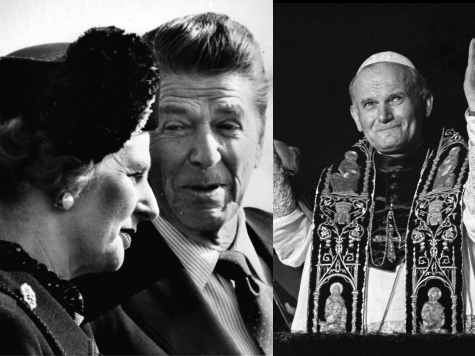
In his tribute to the late former Prime Minister of Great Britain Margaret Thatcher, conservative host Rush Limbaugh said:
Some people call it a coincidence — I think it’s more than that — that at the same time in the world we had Ronald Reagan, Pope John Paul II, and Margaret Thatcher. During those years were the only time in my lifetime where the left was actually turned back. Not just stopped, but defeated and turned back. It was the only time in my life. Poland, Berlin, Moscow, the United States. Wherever. Those three leaders on the political stage, the world stage at the same time, did more for freedom and liberty for people all over this world than any three people since the founding of this country — and they all served at the same time, overlapping.
John O’Sullivan, author of The President, the Pope, And the Prime Minister: Three Who Changed the World, provides an additional lens into the effects of the intersection of these three world leaders.
During the early 1970’s, the three talents were still “middle managers,” taking stock of their own faltering institutions.
O’Sullivan writes:
Karol Wojtyla was the cardinal-archbishop of Cracow, Poland’s second city, in a Church still dominated by an Italian pope and Italian clerical bureaucrats. Margaret Thatcher had just entered the cabinet of Edward Heath’s new Conservative government in the middle-ranking position of minister of education. Ronald Reagan was in his second and final term as governor of California.
“All three had strong personalities, great abilities, and loyal followings,” writes O’Sullivan. He notes, however, that with Reagan “already dangerously close to becoming an elder statesman,” his prospects for advancement were questionable, and Thatcher and Wojtyla were also peaking too short of the top spots in their respective places in the world.
O’Sullivan observes:
It was not hard for any intelligent observer to explain why these three, with such high abilities, had obtained only limited success. All three were handicapped by being too sharp, clear, and definite in an age of increasingly fluid identities and sophisticated doubts. Put simply, Wojtyla was too Catholic, Thatcher too conservative, and Reagan too American.
Yet, Limbaugh’s comment is reflected in O’Sullivan’s remark: “It was a time when historical currents seemed to be smoothly bearing mankind, including the Catholic Church, Britain, and America, in an undeniably liberal and even progressive direction.”
O’Sullivan embarks on a recitation of the “revolutions of every kind- sexual, religious, political, economic, social,” as the three leaders were still not yet in the positions necessary for the potential of their synergy. Sexual liberation, feminism, abortion rights, the attempt to reconcile faith with secular forms of “liberation,” the rise of labor unions, the entrenchment of the welfare state- and its expansion from Europe to America, the new “clout” of the United Nations and, of course, the rise of communism- all awaited the three leaders.
“This new order might have been called Liberaldom,” writes O’Sullivan. “Wojtyla, Thatcher, and Reagan all embodied such fading virtues as faith, self-reliance, and patriotism–which the modern world seemed to be leaving behind.”
Regarding Thatcher, O’Sullivan states:
Wherever she went in Eastern Europe before the fall of Communism, she received a warm, indeed passionate welcome because she was regarded by ordinary Eastern Europeans as a symbol of opposition to Communism.
O’Sullivan describes the roles each leader naturally assumed to bring about greater freedom and liberty for all peoples of the world. They worked in tandem- John Paul, the “orthodox rebel,” and his campaign for religious liberty and support for dissident movements; Thatcher with her economic incentives for communist governments to encourage liberty, her conditions for assistance getting tougher as time went on; and Reagan and his consistent insistence on freedom, and his personal attributes that allowed a direct relationship with Gorbachev.
According to O’Sullivan, when Reagan left office in January of 1989, his last official act as president was a letter to Thatcher that “marked the end of a great political partnership.” O’Sullivan observes that this “extraordinary partnership” worked because the leaders’ personalities were so different: “Reagan’s relaxed self-confidence” and “Thatcher’s stern abilities.”
As for the world leaders’ thoughts about their other partner, John Paul II, O’Sullivan describes a scene in 1979, when Reagan stopped short a discussion with foreign policy adviser, Richard Allen, so the two could watch news coverage of the pope’s first visit to Poland. Amazed by the vast crowds surrounding John Paul, Reagan reportedly was “gripped” by the scene unfolding, and deeply moved. O’Sullivan states that Allen was “convinced that Reagan, like himself, had seen the papal visit as a first, massive crack in the impressive façade of Soviet power.”
In 2009, National Catholic Register reported that former Prime Minister Margaret Thatcher laid flowers, for a second time, at the tomb of Pope John Paul II. According to those who were with Thatcher the first time, she affirmed clearly and loudly that “it was thanks to John Paul that Soviet communism was brought down.”

COMMENTS
Please let us know if you're having issues with commenting.